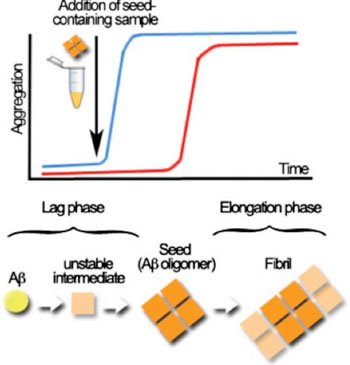Sensitive Biochemical Method Diagnoses Alzheimer’s Disease
By LabMedica International staff writers
Posted on 09 Apr 2014
A sensitive method has been used for the biochemical diagnosis of Alzheimer’s disease (AD) based on specific detection of misfolded amyloid-β (Aβ) oligomers, which play a central role in AD pathogenesis. Posted on 09 Apr 2014
The method can detect tiny, misfolded protein fragments in cerebrospinal fluid taken from patients and lends hope that doctors might soon have a way to diagnose the disease while treatments might have a better chance of working, before extensive brain damage and dementia set in.

Image: Schematics of protein misfolding cyclic amplification (PMCA) technology for amyloid-β (Aβ) oligomers (Photo courtesy of University of Texas Medical School).
Scientists at the University of Texas Medical School (Houston, TX, USA) used cerebral spinal fluid (CSF) samples from 50 patients with the diagnosis of probable AD, determined using a variety of tests, including routine medical examination; neurological evaluation; neuropsychological assessment; and measurements of CSF levels of Aβ1-42, total tau, and phospho-tau. The mean age of AD patients at the time of sample collection was 71.0 years with an age range of 49 to 84. For controls, 39 cognitively normal individuals affected by nondegenerative neurological diseases (NNDs) and 37 patients affected by non-AD neurodegenerative diseases (NANDs) including other forms of dementia were included.
The investigators used the protein misfolding cyclic amplification (PMCA) technology which works by amplifying existing misfolded proteins and then breaking them up into smaller pieces. PMCA combines steps of growing polymers with multiplication of oligomeric seeds to reach an exponential increase of misfolding and aggregation. When mixed with the equivalent, normal protein, the misfolded fragments act as seeds for the formation, in the case of Aβ, of amyloid clumps like those found in the Alzheimer's brain. At various time points, amyloid-binding dye Thioflavin T (ThT) fluorescence was measured in the plates at 485 nm after excitation at 435 nm using a plate spectrofluorometer.
The scientists showed that their technology can detect Aβ oligomers at incredibly low concentrations as the results indicate that using the Aβ-PMCA assay it should be able to detect as little as three femtomoles (fmol) of Aβ oligomers in a given sample. In principle, the work suggests it might be possible to detect even a single particle of misfolded Aβ. Most importantly, the team was able to distinguish between patients with Alzheimer's disease and those with other neurodegenerative or neurological disorders with 90% sensitivity and 92% specificity by applying their test to cerebrospinal fluid samples.
Claudio Soto, PhD, the lead author of the study, said, “The next step is to adapt the technology for use with blood or urine samples, which would be much easier to obtain for screening perfectly healthy people for biochemical signs of Alzheimer's disease. We will also continue to explore its utility for detecting the disease before symptoms appear.” The study was published on March 20, 2014, in the journal Cell Reports.
Related Links:
University of Texas Medical School








 (3) (1).png)




